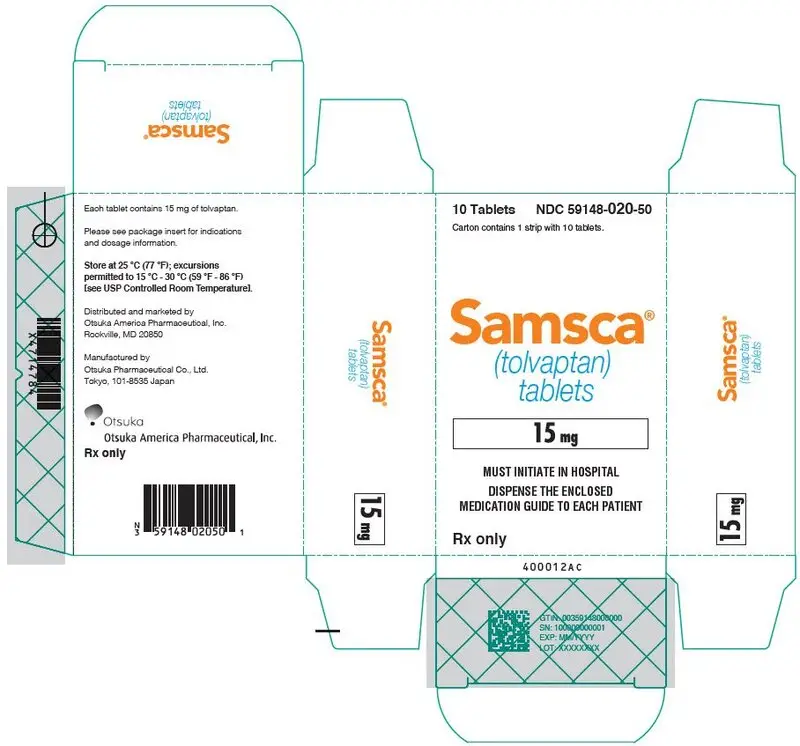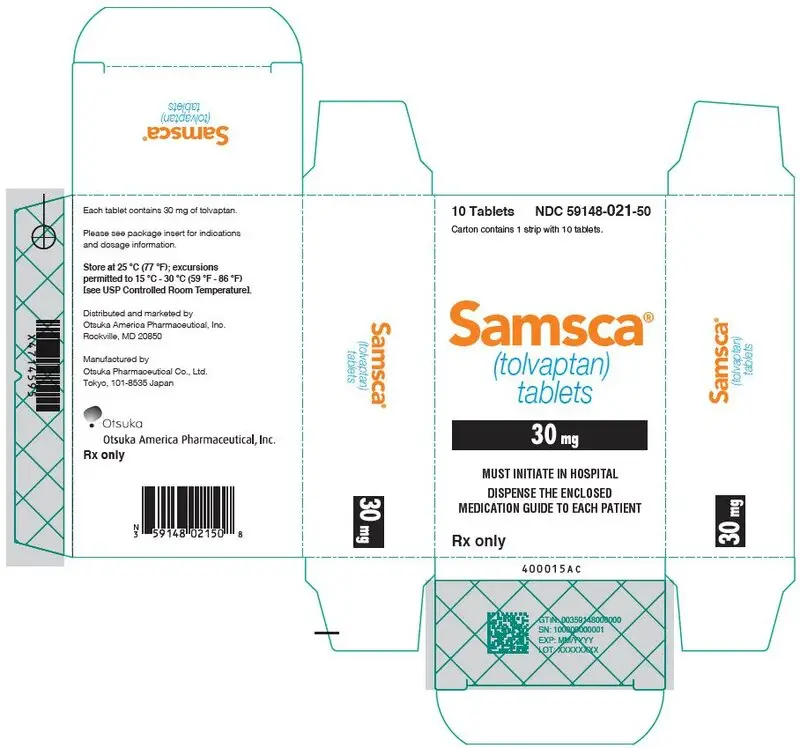Drug Detail:Samsca (Tolvaptan [ tol-vap-tan ])
Drug Class: Vasopressin antagonists
Highlights of Prescribing Information
SAMSCA® (tolvaptan) tablets, for oral use
Initial U.S. Approval: 2009
WARNING: (A) INITIATE AND RE-INITIATE IN A HOSPITAL AND MONITOR SERUM SODIUM (B) NOT FOR USE FOR AUTOSOMAL DOMINANT POLYCYSTIC KIDNEY DISEASE (ADPKD)
See full prescribing information for complete boxed warning.
(A) Initiate and re-initiate in a hospital and monitor serum sodium
- SAMSCA should be initiated and re-initiated in patients only in a hospital where serum sodium can be monitored closely.
- Too rapid correction of hyponatremia (e.g., >12 mEq/L/24 hours) can cause osmotic demyelination resulting in dysarthria, mutism, dysphagia, lethargy, affective changes, spastic quadriparesis, seizures, coma and death. In susceptible patients, including those with severe malnutrition, alcoholism or advanced liver disease, slower rates of correction may be advisable.
(B) Not for use for autosomal dominant polycystic kidney disease (ADPKD)
- Because of the risk of hepatotoxicity, tolvaptan should not be used for ADPKD outside of the FDA-approved REMS (4)
Recent Major Changes
| Warnings and Precautions (5.5, 5.7) | 04/2021 |
Indications and Usage for Samsca
SAMSCA is a selective vasopressin V2-receptor antagonist indicated for the treatment of clinically significant hypervolemic and euvolemic hyponatremia [serum sodium <125 mEq/L or less marked hyponatremia that is symptomatic and has resisted correction with fluid restriction], including patients with heart failure and Syndrome of Inappropriate Antidiuretic Hormone (SIADH) (1)
Limitations of Use:
- Patients requiring intervention to raise serum sodium urgently to prevent or to treat serious neurological symptoms should not be treated with SAMSCA (1)
- It has not been established that SAMSCA provides a symptomatic benefit to patients (1)
Samsca Dosage and Administration
- SAMSCA should be initiated and re-initiated in a hospital (2.1)
- The recommended starting dose is 15 mg once daily. Dosage may be increased at intervals ≥24 hr to 30 mg once daily, and to a maximum of 60 mg once daily as needed to raise serum sodium. (2.1)
Dosage Forms and Strengths
- Tablets: 15 mg and 30 mg (3)
Contraindications
- Use in patients with autosomal dominant polycystic kidney disease (ADPKD) outside of FDA-approved REMS (4)
- Patients who are unable to respond appropriately to thirst (4)
- Hypovolemic hyponatremia (4)
- Concomitant use of strong CYP3A inhibitors (4)
- Anuria (4)
- Hypersensitivity (4)
Warnings and Precautions
- Liver injury: Limit treatment duration to 30 days. If hepatic injury is suspected, discontinue SAMSCA. Avoid use in patients with underlying liver disease (5.2)
- Dehydration and hypovolemia may require intervention (5.3)
- Avoid use with hypertonic saline (5.4)
- Avoid use with moderate to strong CYP3A inhibitors (5.5)
- Monitor serum potassium in patients with potassium >5 mEq/L or on drugs known to increase potassium (5.6)
- Urinary outflow obstruction: Urinary output must be secured (5.7)
Adverse Reactions/Side Effects
Most common adverse reactions (≥5% placebo) are thirst, dry mouth, asthenia, constipation, pollakiuria or polyuria, and hyperglycemia (6.1)
To report SUSPECTED ADVERSE REACTIONS, contact Otsuka at 1-877-726-7220 or FDA at 1-800-FDA-1088 (www.fda.gov/medwatch).
Drug Interactions
Avoid concomitant use with:
- Moderate CYP3A inhibitors (7.1)
- Strong CYP3A inducers (7.1)
- V2-receptor antagonists (7.3)
Monitor serum potassium during concomitant therapy with (7.2):
- Angiotensin receptor blockers
- Angiotensin converting enzyme inhibitors
- Potassium sparing diuretics
Use In Specific Populations
- Pregnancy: May cause fetal harm (8.1)
- Lactation: Breastfeeding not recommended (8.2)
- Pediatric Use: There are no studies (8.4)
See 17 for PATIENT COUNSELING INFORMATION and Medication Guide.
Revised: 4/2021
Related/similar drugs
urea, tolvaptan, sodium acetate, ure-Na, conivaptanFull Prescribing Information
WARNING: (A) INITIATE AND RE-INITIATE IN A HOSPITAL AND MONITOR SERUM SODIUM (B) NOT FOR USE FOR AUTOSOMAL DOMINANT POLYCYSTIC KIDNEY DISEASE (ADPKD)
1. Indications and Usage for Samsca
SAMSCA® is indicated for the treatment of clinically significant hypervolemic and euvolemic hyponatremia (serum sodium <125 mEq/L or less marked hyponatremia that is symptomatic and has resisted correction with fluid restriction), including patients with heart failure and Syndrome of Inappropriate Antidiuretic Hormone (SIADH).
2. Samsca Dosage and Administration
2.1 Recommended Dosage
Patients should be in a hospital for initiation and re-initiation of therapy to evaluate the therapeutic response and because too rapid correction of hyponatremia can cause osmotic demyelination resulting in dysarthria, mutism, dysphagia, lethargy, affective changes, spastic quadriparesis, seizures, coma and death.
The usual starting dose for SAMSCA is 15 mg administered once daily without regard to meals. Increase the dose to 30 mg once daily, after at least 24 hours, to a maximum of 60 mg once daily, as needed to achieve the desired level of serum sodium. Do not administer SAMSCA for more than 30 days to minimize the risk of liver injury [see Warnings and Precautions (5.2)].
During initiation and titration, frequently monitor for changes in serum electrolytes and volume. Avoid fluid restriction during the first 24 hours of therapy. Patients receiving SAMSCA should be advised that they can continue ingestion of fluid in response to thirst [see Warnings and Precautions (5.1)].
3. Dosage Forms and Strengths
SAMSCA is available in the following dosage forms and strengths:
- 15 mg tablets are non-scored, blue, triangular, shallow-convex, debossed with "OTSUKA" and "15" on one side.
- 30 mg tablets are non-scored, blue, round, shallow-convex, debossed with "OTSUKA" and "30" on one side.
4. Contraindications
SAMSCA is contraindicated in the following conditions:
- Patients with autosomal dominant polycystic kidney disease (ADPKD) outside of FDA-approved REMS [see Warnings and Precautions (5.2)]
- Unable to sense or respond to thirst
- Hypovolemic hyponatremia
- Taking strong CYP3A inhibitors [see Warnings and Precautions (5.5)]
- Anuria
- Hypersensitivity (e.g., anaphylactic shock, rash generalized) to tolvaptan or any components of the product [see Adverse Reactions (6)]
5. Warnings and Precautions
5.1 Too Rapid Correction of Serum Sodium Can Cause Serious Neurologic Sequelae
Osmotic demyelination syndrome is a risk associated with too rapid correction of hyponatremia (e.g., >12 mEq/L/24 hours). Osmotic demyelination results in dysarthria, mutism, dysphagia, lethargy, affective changes, spastic quadriparesis, seizures, coma or death. In susceptible patients, including those with severe malnutrition, alcoholism or advanced liver disease, slower rates of correction may be advisable. In controlled clinical trials in which tolvaptan was administered in titrated doses starting at 15 mg once daily, 7% of tolvaptan-treated subjects with a serum sodium <130 mEq/L had an increase in serum sodium greater than 8 mEq/L at approximately 8 hours and 2% had an increase greater than 12 mEq/L at 24 hours. Approximately 1% of placebo-treated subjects with a serum sodium <130 mEq/L had a rise greater than 8 mEq/L at 8 hours and no patient had a rise greater than 12 mEq/L/24 hours. Osmotic demyelination syndrome has been reported in association with SAMSCA therapy [see Adverse Reactions (6.2)]. Patients treated with SAMSCA should be monitored to assess serum sodium concentrations and neurologic status, especially during initiation and after titration. Subjects with SIADH or very low baseline serum sodium concentrations may be at greater risk for too-rapid correction of serum sodium. In patients receiving SAMSCA who develop too rapid a rise in serum sodium, discontinue or interrupt treatment with SAMSCA and consider administration of hypotonic fluid. Fluid restriction during the first 24 hours of therapy with SAMSCA may increase the likelihood of overly rapid correction of serum sodium and should generally be avoided. Co-administration of diuretics also increases the risk of too rapid correction of serum sodium and such patients should undergo close monitoring of serum sodium.
5.2 Liver Injury
Tolvaptan can cause serious and potentially fatal liver injury. In placebo-controlled studies and an open-label extension study of chronically administered tolvaptan in patients with ADPKD, cases of serious liver injury attributed to tolvaptan, generally occurring during the first 18 months of therapy, were observed. In postmarketing experience with tolvaptan in ADPKD, acute injury resulting in liver failure requiring liver transplantation has been reported. Tolvaptan should not be used to treat ADPKD outside of the FDA-approved risk evaluation and mitigation strategy (REMS) for ADPKD patients [see Contraindications (4)].
Patients with symptoms that may indicate liver injury, including fatigue, anorexia, right upper abdominal discomfort, dark urine or jaundice should discontinue treatment with SAMSCA.
Limit duration of therapy with SAMSCA to 30 days. Avoid use in patients with underlying liver disease, including cirrhosis, because the ability to recover from liver injury may be impaired [see Adverse Reactions (6.1)].
5.3 Dehydration and Hypovolemia
SAMSCA therapy induces copious aquaresis, which is normally partially offset by fluid intake. Dehydration and hypovolemia can occur, especially in potentially volume-depleted patients receiving diuretics or those who are fluid restricted. In multiple-dose, placebo-controlled trials in which 607 hyponatremic patients were treated with tolvaptan, the incidence of dehydration was 3.3% for tolvaptan and 1.5% for placebo-treated patients. In patients receiving SAMSCA who develop medically significant signs or symptoms of hypovolemia, interrupt or discontinue SAMSCA therapy and provide supportive care with careful management of vital signs, fluid balance and electrolytes. Fluid restriction during therapy with SAMSCA may increase the risk of dehydration and hypovolemia. Patients receiving SAMSCA should continue ingestion of fluid in response to thirst.
5.4 Co-administration with Hypertonic Saline
Concomitant use with hypertonic saline is not recommended.
5.5 Drug Interactions
Tolvaptan is a substrate of CYP3A. Moderate to strong CYP3A inhibitors can lead to a marked increase in tolvaptan concentrations [see Drug Interactions (7.1)]. Do not use SAMSCA with strong inhibitors of CYP3A [see Contraindications (4)] and avoid concomitant use with moderate CYP3A inhibitors.
5.6 Hyperkalemia or Drugs that Increase Serum Potassium
Treatment with tolvaptan is associated with an acute reduction of the extracellular fluid volume which could result in increased serum potassium. Serum potassium levels should be monitored after initiation of tolvaptan treatment in patients with a serum potassium >5 mEq/L as well as those who are receiving drugs known to increase serum potassium levels.
5.7 Acute Urinary Retention with Outflow Obstruction
Patients with partial obstruction of urinary outflow, for example, patients with prostatic hypertrophy or impairment of micturition, have an increased risk of developing acute retention. Do not administer tolvaptan in patients with uncorrected urinary outflow obstruction.
6. Adverse Reactions/Side Effects
6.1 Clinical Trials Experience
Because clinical trials are conducted under widely varying conditions, adverse reactions rates observed in the clinical trials of a drug cannot be directly compared to rates in the clinical trials of another drug and may not reflect the rates observed in practice. The adverse event information from clinical trials does, however, provide a basis for identifying the adverse events that appear to be related to drug use and for approximating rates.
In multiple-dose, placebo-controlled trials, 607 hyponatremic patients (serum sodium <135 mEq/L) were treated with SAMSCA. The mean age of these patients was 62 years; 70% of patients were male and 82% were Caucasian. One hundred eighty-nine (189) tolvaptan-treated patients had a serum sodium <130 mEq/L, and 52 patients had a serum sodium <125 mEq/L. Hyponatremia was attributed to cirrhosis in 17% of patients, heart failure in 68% and SIADH/other in 16%. Of these patients, 223 were treated with the recommended dose titration (15 mg titrated to 60 mg as needed to raise serum sodium).
Overall, over 4,000 patients have been treated with oral doses of tolvaptan in open-label or placebo-controlled clinical trials. Approximately 650 of these patients had hyponatremia; approximately 219 of these hyponatremic patients were treated with tolvaptan for 6 months or more.
The most common adverse reactions (incidence ≥5% more than placebo) seen in two 30‑day, double-blind, placebo-controlled hyponatremia trials in which tolvaptan was administered in titrated doses (15 mg to 60 mg once daily) were thirst, dry mouth, asthenia, constipation, pollakiuria or polyuria and hyperglycemia. In these trials, 10% (23/223) of tolvaptan-treated patients discontinued treatment because of an adverse event, compared to 12% (26/220) of placebo-treated patients; no adverse reaction resulting in discontinuation of trial medication occurred at an incidence of >1% in tolvaptan-treated patients.
Table 1 lists the adverse reactions reported in tolvaptan-treated patients with hyponatremia (serum sodium <135 mEq/L) and at a rate at least 2% greater than placebo-treated patients in two 30‑day, double-blind, placebo-controlled trials. In these studies, 223 patients were exposed to tolvaptan (starting dose 15 mg, titrated to 30 and 60 mg as needed to raise serum sodium). Adverse events resulting in death in these trials were 6% in tolvaptan-treated patients and 6% in placebo-treated patients.
| System Organ Class MedDRA Preferred Term | Tolvaptan 15 mg/day to 60 mg/day (N =223) n (%) | Placebo (N =220) n (%) |
|---|---|---|
| The following terms are subsumed under the referenced ADR in Table 1: | ||
|
||
| Gastrointestinal Disorders | ||
| Dry mouth | 28 (13) | 9 (4) |
| Constipation | 16 (7) | 4 (2) |
| General Disorders and Administration Site Conditions | ||
| Thirst* | 35 (16) | 11 (5) |
| Asthenia | 19 (9) | 9 (4) |
| Pyrexia | 9 (4) | 2 (1) |
| Metabolism and Nutrition Disorders | ||
| Hyperglycemia† | 14 (6) | 2 (1) |
| Anorexia‡ | 8 (4) | 2 (1) |
| Renal and Urinary Disorders | ||
| Pollakiuria or polyuria§ | 25 (11) | 7 (3) |
In a subgroup of patients with hyponatremia (N =475, serum sodium <135 mEq/L) enrolled in a double-blind, placebo-controlled trial (mean duration of treatment was 9 months) of patients with worsening heart failure, the following adverse reactions occurred in tolvaptan-treated patients at a rate at least 2% greater than placebo: mortality (42% tolvaptan, 38% placebo), nausea (21% tolvaptan, 16% placebo), thirst (12% tolvaptan, 2% placebo), dry mouth (7% tolvaptan, 2% placebo) and polyuria or pollakiuria (4% tolvaptan, 1% placebo).
6.2 Postmarketing Experience
The following adverse reactions have been identified during post-approval use of SAMSCA. Because these reactions are reported voluntarily from a population of an unknown size, it is not always possible to reliably estimate their frequency or establish a causal relationship to drug exposure.
Neurologic: Osmotic demyelination syndrome
Investigations: Hypernatremia
Removal of excess free body water increases serum osmolality and serum sodium concentrations. All patients treated with tolvaptan, especially those whose serum sodium levels become normal, should continue to be monitored to ensure serum sodium remains within normal limits. If hypernatremia is observed, management may include dose decreases or interruption of tolvaptan treatment, combined with modification of free-water intake or infusion. During clinical trials of hyponatremic patients, hypernatremia was reported as an adverse event in 0.7% of patients receiving tolvaptan vs. 0.6% of patients receiving placebo; analysis of laboratory values demonstrated an incidence of hypernatremia of 1.7% in patients receiving tolvaptan vs. 0.8% in patients receiving placebo.
Immune System Disorders: Hypersensitivity reactions including anaphylactic shock and rash generalized.
7. Drug Interactions
7.2 Angiotensin Receptor Blockers, Angiotensin Converting Enzyme Inhibitors and Potassium Sparing Diuretics
Although specific interaction studies were not performed, in clinical studies, tolvaptan was used concomitantly with beta-blockers, angiotensin receptor blockers, angiotensin converting enzyme inhibitors and potassium sparing diuretics. Adverse reactions of hyperkalemia were approximately 1 to 2% higher when tolvaptan was administered with angiotensin receptor blockers, angiotensin converting enzyme inhibitors and potassium sparing diuretics compared to administration of these medications with placebo. Serum potassium levels should be monitored during concomitant drug therapy.
8. Use In Specific Populations
8.2 Lactation
Data
In lactating rats administered radiolabeled tolvaptan, lacteal radioactivity concentrations reached the highest level at 8 hours after administration and then decreased gradually with time with a half-life of 27.3 hours. The level of activity in milk ranged from 1.5- to 15.8-fold those in maternal blood over a period of 72 hours post-dose. Increased perinatal death and decreased body weight of the offspring were observed during the lactation period and after weaning at approximately 11 times the exposure in CHF patients at the MRHD of 60 mg.
8.4 Pediatric Use
Safety and effectiveness of SAMSCA in pediatric patients have not been established.
8.5 Geriatric Use
Of the total number of hyponatremic subjects treated with SAMSCA in clinical studies, 42% were 65 years old and over, while 19% were 75 years old and over. No overall differences in safety or effectiveness were observed between these subjects and younger subjects, and other reported clinical experience has not identified differences in responses between the elderly and younger patients, but greater sensitivity of some older individuals cannot be ruled out. Increasing age has no effect on tolvaptan plasma concentrations.
8.6 Use in Patients with Hepatic Impairment
Moderate and severe hepatic impairment do not affect exposure to tolvaptan to a clinically relevant extent. Avoid use of tolvaptan in patients with underlying liver disease.
8.7 Use in Patients with Renal Impairment
No dose adjustment is necessary based on renal function. There are no clinical trial data in patients with CrCl <10 mL/min, and, because drug effects on serum sodium levels are likely lost at very low levels of renal function, use in patients with a CrCl <10 mL/min is not recommended. No benefit can be expected in patients who are anuric [see Contraindications (4) and Clinical Pharmacology (12.3)].
10. Overdosage
Single oral doses up to 480 mg (8 times the maximum recommended daily dose) and multiple doses up to 300 mg once daily for 5 days have been well tolerated in studies in healthy subjects. There is no specific antidote for tolvaptan intoxication. The signs and symptoms of an acute overdose can be anticipated to be those of excessive pharmacologic effect: a rise in serum sodium concentration, polyuria, thirst, and dehydration/hypovolemia.
No mortality was observed in rats or dogs following single oral doses of 2000 mg/kg (maximum feasible dose). A single oral dose of 2000 mg/kg was lethal in mice, and symptoms of toxicity in affected mice included decreased locomotor activity, staggering gait, tremor and hypothermia.
In patients with suspected SAMSCA overdosage, assessment of vital signs, electrolyte concentrations, ECG and fluid status are recommended. Continue replacement of water and electrolytes until aquaresis abates.
Dialysis may not be effective in removing tolvaptan because of its high binding affinity for human plasma protein (>98%).
11. Samsca Description
SAMSCA contains tolvaptan, a selective vasopressin V2-receptor antagonist in tablets for oral use available in 15 mg or 30 mg strengths. Tolvaptan is (±)-4'-[(7-chloro-2,3,4,5-tetrahydro-5-hydroxy-1H-1-benzazepin-1-yl) carbonyl]-o-tolu-m-toluidide. The empirical formula is C26H25ClN2O3. Molecular weight is 448.94. The chemical structure is:
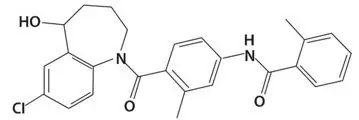
Inactive ingredients include corn starch, hydroxypropyl cellulose, lactose monohydrate, low-substituted hydroxypropyl cellulose, magnesium stearate, microcrystalline cellulose, and FD&C Blue No. 2 Aluminum Lake as colorant.
12. Samsca - Clinical Pharmacology
12.1 Mechanism of Action
Tolvaptan is a selective vasopressin V2-receptor antagonist with an affinity for the V2-receptor that is 1.8 times that of native arginine vasopressin (AVP). Tolvaptan affinity for the V2-receptor is 29 times greater than for the V1a-receptor. When taken orally, 15 to 60 mg doses of tolvaptan antagonize the effect of vasopressin and cause an increase in urine water excretion that results in an increase in free water clearance (aquaresis), a decrease in urine osmolality, and a resulting increase in serum sodium concentrations. Urinary excretion of sodium and potassium and plasma potassium concentrations are not significantly changed. Tolvaptan metabolites have no or weak antagonist activity for human V2-receptors compared with tolvaptan.
12.2 Pharmacodynamics
In healthy subjects receiving a single dose of SAMSCA 60 mg, the onset of the aquaretic and sodium increasing effects occurs within 2 to 4 hours post-dose. A peak effect of about a 6 mEq increase in serum sodium and about 9 mL/min increase in urine excretion rate is observed between 4 and 8 hours post-dose; thus, the pharmacological activity lags behind the plasma concentrations of tolvaptan. About 60% of the peak effect on serum sodium is sustained at 24 hours post-dose, but the urinary excretion rate is no longer elevated by this time. Doses above 60 mg tolvaptan do not increase aquaresis or serum sodium further. The effects of tolvaptan in the recommended dose range of 15 to 60 mg once daily appear to be limited to aquaresis and the resulting increase in sodium concentration.
Plasma concentrations of native AVP may increase (avg. 2 to 9 pg/mL) with tolvaptan administration.
12.3 Pharmacokinetics
In healthy subjects, the pharmacokinetics of tolvaptan after single doses of up to 480 mg and multiple doses up to 300 mg once daily have been examined. In hyponatremia subjects, single and multiple doses up to 60 mg have been studied.
14. Clinical Studies
14.1 Hyponatremia
In two double-blind, placebo-controlled, multi-center studies (SALT-1 and SALT-2), a total of 424 patients with euvolemic or hypervolemic hyponatremia (serum sodium <135 mEq/L) resulting from a variety of underlying causes (heart failure, liver cirrhosis, syndrome of inappropriate antidiuretic hormone [SIADH] and others) were treated for 30 days with tolvaptan or placebo, then followed for an additional 7 days after withdrawal. Symptomatic patients, patients likely to require saline therapy during the course of therapy, patients with acute and transient hyponatremia associated with head trauma or postoperative state and patients with hyponatremia due to primary polydipsia, uncontrolled adrenal insufficiency or uncontrolled hypothyroidism were excluded. Patients were randomized to receive either placebo (N =220) or tolvaptan (N =223) at an initial oral dose of 15 mg once daily. The mean serum sodium concentration at study entry was 129 mEq/L. Fluid restriction was to be avoided if possible during the first 24 hours of therapy to avoid overly rapid correction of serum sodium, and during the first 24 hours of therapy 87% of patients had no fluid restriction. Thereafter, patients could resume or initiate fluid restriction (defined as daily fluid intake of ≤1.0 liter/day) as clinically indicated.
The dose of tolvaptan could be increased at 24-hour intervals to 30 mg once daily, then to 60 mg once daily, until either the maximum dose of 60 mg or normonatremia (serum sodium >135 mEq/L) was reached. Serum sodium concentrations were determined at 8 hours after study drug initiation and daily up to 72 hours, within which time titration was typically completed. Treatment was maintained for 30 days with additional serum sodium assessments on Days 11, 18, 25 and 30. On the day of study discontinuation, all patients resumed previous therapies for hyponatremia and were reevaluated 7 days later. The primary endpoint for these studies was the average daily AUC for change in serum sodium from baseline to Day 4 and baseline to Day 30 in patients with a serum sodium less than 135 mEq/L. Compared to placebo, tolvaptan caused a statistically greater increase in serum sodium (p <0.0001) during both periods in both studies (see Table 2). For patients with a serum sodium of <130 mEq/L or <125 mEq/L, the effects at Day 4 and Day 30 remained significant (see Table 2). This effect was also seen across all disease etiology subsets (e.g., CHF, cirrhosis, SIADH/other).
| Tolvaptan 15 mg/day to 60 mg/day | Placebo | Estimated Effect (95% CI) |
|
|---|---|---|---|
|
|||
| Subjects with Serum Sodium <135 mEq/L (ITT population) | |||
| Change in average daily serum [Na+] AUC baseline to Day 4 (mEq/L) Mean (SD) N | 4.0 (2.8) 213 | 0.4 (2.4) 203 | 3.7 (3.3 to 4.2) p <0.0001 |
| Change in average daily serum [Na+] AUC baseline to Day 30 (mEq/L) Mean (SD) N | 6.2 (4.0) 213 | 1.8 (3.7) 203 | 4.6 (3.9 to 5.2) p <0.0001 |
| Percent of Patients Needing Fluid Restriction* | 14% 30/215 | 25% 51/206 | p =0.0017 |
| Subgroup with Serum Sodium <130 mEq/L | |||
| Change in average daily serum [Na+] AUC baseline to Day 4 (mEq/L) Mean (SD) N | 4.8 (3.0) 110 | 0.7 (2.5) 105 | 4.2 (3.5 to 5.0) p <0.0001 |
| Change in average daily serum [Na+] AUC baseline to Day 30 (mEq/L) Mean (SD) N | 7.9 (4.1) 110 | 2.6 (4.2) 105 | 5.5 (4.4 to 6.5) p <0.0001 |
| Percent of Patients Needing Fluid Restriction* | 19% 21/110 | 36% 38/106 | p <0.01 |
| Subgroup with Serum Sodium <125 mEq/L | |||
| Change in average daily serum [Na+] AUC baseline to Day 4 (mEq/L) Mean (SD) N | 5.7 (3.8) 26 | 1.0 (1.8) 30 | 5.3 (3.8 to 6.9) p <0.0001 |
| Change in average daily serum [Na+] AUC baseline to Day 30 (mEq/L) Mean (SD) N | 10.0 (4.8) 26 | 4.1 (4.5) 30 | 5.7 (3.1 to 8.3) p <0.0001 |
| Percent of Patients Needing Fluid Restriction* | 35% 9/26 | 50% 15/30 | p =0.14 |
In patients with hyponatremia (defined as <135 mEq/L), serum sodium concentration increased to a significantly greater degree in tolvaptan-treated patients compared to placebo-treated patients as early as 8 hours after the first dose, and the change was maintained for 30 days. The percentage of patients requiring fluid restriction (defined as ≤1 L/day at any time during the treatment period) was also significantly less (p =0.0017) in the tolvaptan-treated group (30/215, 14%) as compared with the placebo-treated group (51/206, 25%).
Figure 1 shows the change from baseline in serum sodium by visit in patients with serum sodium <135 mEq/L. Within 7 days of tolvaptan discontinuation, serum sodium concentrations in tolvaptan-treated patients declined to levels similar to those of placebo-treated patients.
Figure 1: Pooled SALT Studies: Analysis of Mean Serum Sodium (± SD, mEq/L) by Visit - Patients with Baseline Serum Sodium <135 mEq/L
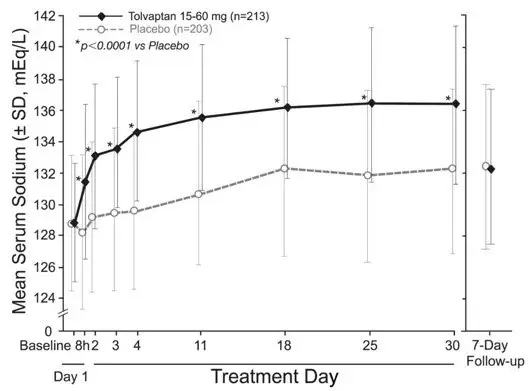
*p-value <0.0001 for all visits during tolvaptan treatment compared to placebo
Figure 2: Pooled SALT Studies: Analysis of Mean Serum Sodium (± SD, mEq/L) by Visit - Patients with Baseline Serum Sodium <130 mEq/L
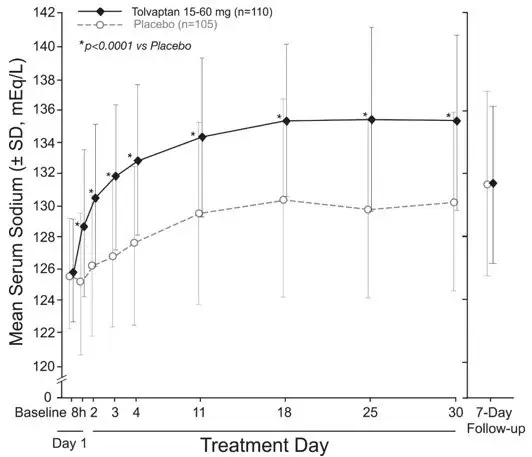
*p-value <0.0001 for all visits during tolvaptan treatment compared to placebo
In the open-label study SALTWATER, 111 patients, 94 of them hyponatremic (serum sodium <135 mEq/L), previously on tolvaptan or placebo therapy, were given tolvaptan as a titrated regimen (15 to 60 mg once daily) after having returned to standard care for at least 7 days. By this time, their baseline mean serum sodium concentration had fallen to between their original baseline and post-placebo therapy level. Upon initiation of therapy, average serum sodium concentrations increased to approximately the same levels as observed for those previously treated with tolvaptan and were sustained for at least a year. Figure 3 shows results from 111 patients enrolled in the SALTWATER Study.
Figure 3: SALTWATER: Analysis of Mean Serum Sodium (± SD, mEq/L) by Visit
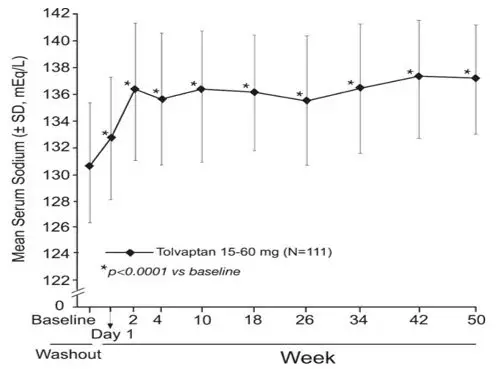
*p-value <0.0001 for all visits during tolvaptan treatment compared to baseline
14.2 Heart Failure
In a phase 3 double-blind, placebo-controlled study (EVEREST), 4133 patients with worsening heart failure were randomized to tolvaptan or placebo as an adjunct to standard of care. Long-term tolvaptan treatment (mean duration of treatment of 0.75 years) had no demonstrated effect, either favorable or unfavorable, on all-cause mortality [HR (95% CI): 0.98 (0.9, 1.1)] or the combined endpoint of CV mortality or subsequent hospitalization for worsening HF [HR (95% CI): 1.0 (0.9, 1.1)].
17. Patient Counseling Information
As a part of patient counseling, healthcare providers must review the SAMSCA Medication Guide with every patient [see FDA-Approved Medication Guide].
Medication Guide
SAMSCA® (sam-sca)
tolvaptan
Tablets
Read the Medication Guide that comes with SAMSCA before you take it and each time you get a new prescription. There may be new information. This Medication Guide does not take the place of talking to your healthcare provider about your medical condition or your treatment. Share this important information with members of your household.
What is the most important information I should know about SAMSCA?
1) SAMSCA may make the salt (sodium) level in your blood rise too fast. This can increase your risk of a serious condition called osmotic demyelination syndrome (ODS). ODS can lead to coma or death. ODS can also cause new symptoms such as:
- trouble speaking
- swallowing trouble or feeling like food or liquid gets stuck while swallowing
- drowsiness
- confusion
- mood changes
- trouble controlling body movement (involuntary movement) and weakness in muscles of the arms and legs
- seizures
You or a family member should tell your healthcare provider right away if you have any of these symptoms even if they begin later in treatment. Also tell your healthcare provider about any other new symptoms while taking SAMSCA.
You may be more at risk for ODS if you have:
- liver disease
- not eaten enough for a long period of time (malnourished)
- very low sodium level in your blood
- been drinking large amounts of alcohol for a long period of time (chronic alcoholism)
To lessen your risk of ODS while taking SAMSCA:
- Treatment with SAMSCA should be started and re-started only in a hospital, where the sodium levels in your blood can be checked closely.
- Do not take SAMSCA if you cannot tell if you are thirsty.
- To prevent losing too much body water (dehydration), have water available to drink at all times while taking SAMSCA. Unless your healthcare provider tells you otherwise, drink when you are thirsty.
- If your healthcare provider tells you to keep taking SAMSCA after you leave a hospital, it is important that you do not stop and re-start SAMSCA on your own. You may need to go back to a hospital to re-start SAMSCA. Talk to your healthcare provider right away if you stop taking SAMSCA for any reason.
- It is important to stay under the care of your healthcare provider while taking SAMSCA and follow their instructions.
2) SAMSCA may cause liver problems, including life-threatening liver failure. SAMSCA should not be taken for more than 30 days. Tell your doctor right away if you develop or have worsening of any of these signs and symptoms of liver problems:
- Loss of appetite, nausea, vomiting
- Fever, feeling unwell, unusual tiredness
- Itching
- Yellowing of the skin or the whites of the eyes (jaundice)
- Unusual darkening of the urine
- Right upper stomach area pain or discomfort
3) If you have autosomal dominant polycystic kidney disease (ADPKD), do not use SAMSCA because you should receive the medicine (tolvaptan) through a program that ensures laboratory monitoring of your liver.
What is SAMSCA?
SAMSCA is a prescription medicine used to help increase low sodium levels in the blood, in adults with conditions such as heart failure, and certain hormone imbalances. SAMSCA helps raise salt levels in your blood by removing extra body water as urine.
It is not known if SAMSCA is safe or works in children.
Do not take SAMSCA if:
- you are allergic to tolvaptan or any of the ingredients in SAMSCA. See the end of this Medication Guide for a complete list of ingredients in SAMSCA.
- the sodium level in your blood must be increased right away.
- you cannot replace fluids by drinking or you cannot feel if you are thirsty.
- you are dizzy, faint, or your kidneys are not working normally because you have lost too much body fluid.
- you take certain medicines. These medicines could cause you to have too much SAMSCA in your blood:
- the antibiotic medicines, clarithromycin (Biaxin, Biaxin XL) or telithromycin (Ketek)
- the antifungal medicines, ketoconazole (Nizoral) or itraconazole (Sporanox)
- the anti-HIV medicines, ritonavir (Kaletra, Norvir), indinavir (Crixivan), nelfinavir (Viracept), and saquinavir (Invirase)
- the antidepressant medicine, nefazodone hydrochloride
- your body is not able to make urine. SAMSCA will not help your condition.
What should I tell my healthcare provider before taking SAMSCA?
Tell your healthcare provider about all your medical conditions, including if you:
- have kidney problems and your body cannot make urine.
- have liver problems
- cannot feel if you are thirsty. See "What is the most important information I should know about SAMSCA?"
- had an allergic reaction in the past to tolvaptan or to any of the other ingredients of this medicine. See the end of this Medication Guide for a list of the ingredients in SAMSCA.
- are pregnant or plan to become pregnant. It is not known if SAMSCA will harm your unborn baby.
- are breast-feeding. It is not known if SAMSCA passes into your breast milk. You and your healthcare provider should decide if you will take SAMSCA or breast-feed. You should not do both.
- are taking desmopressin (dDAVP).
Tell your healthcare provider about all the medicines you take, including prescription and non-prescription medicines, vitamins, and herbal supplements.
Using SAMSCA with certain medicines could cause you to have too much SAMSCA in your blood. See "Who should not take SAMSCA?"
SAMSCA may affect the way other medicines work and other medicines may affect how SAMSCA works.
Know the medicines you take. Keep a list of them and show it to your healthcare provider and pharmacist when you get a new medicine.
How should I take SAMSCA?
- See "What is the most important information I should know about SAMSCA?"
- Take SAMSCA exactly as prescribed by your healthcare provider.
- Take SAMSCA one time each day.
- You can take SAMSCA with or without food.
- Do not drink grapefruit juice during treatment with SAMSCA. This could cause you to have too much SAMSCA in your blood.
- Certain medicines or illnesses may keep you from drinking fluids or may cause you to lose too much body fluid, such as vomiting or diarrhea. If you have these problems, call your healthcare provider right away.
- Do not miss or skip doses of SAMSCA. If you miss a dose, take it as soon as you remember. If it is near the time of the next dose, skip the missed dose. Just take the next dose at your regular time. Do not take 2 doses at the same time.
- If you take too much SAMSCA, call your healthcare provider right away. If you take an overdose of SAMSCA, you may need to go to a hospital.
- If your healthcare provider tells you to stop taking SAMSCA, follow their instructions about limiting the amount of fluid you should drink.
What are the possible side effects of SAMSCA?
SAMSCA can cause serious side effects including:
- See "What is the most important information I should know about SAMSCA?"
-
Loss of too much body fluid (dehydration). Tell your healthcare provider if you:
- have vomiting or diarrhea and cannot drink normally.
- feel dizzy or faint. These may be symptoms that you have lost too much body fluid.
Call your healthcare provider right away if you have any of these symptoms.
The most common side effects of SAMSCA are:
- thirst
- dry mouth
- weakness
- constipation
- making large amounts of urine and urinating often
- increased blood sugar levels
These are not all the possible side effects of SAMSCA. Talk to your healthcare provider about any side effect that bothers you or that does not go away while taking SAMSCA.
Call your doctor for medical advice about side effects. You may report side effects to FDA at 1-800-FDA-1088.
How should I store SAMSCA?
Store SAMSCA between 59°F to 86°F (15°C to 30°C).
Keep SAMSCA and all medicines out of the reach of children.
General Information about SAMSCA
Medicines are sometimes prescribed for purposes other than those listed in a Medication Guide. Do not use SAMSCA for a condition for which it was not prescribed. Do not give SAMSCA to other people, even if they have the same symptoms you have. It may harm them.
This Medication Guide summarizes the most important information about SAMSCA. If you would like more information, talk with your healthcare provider. You can ask your healthcare provider or pharmacist for information about SAMSCA that is written for healthcare professionals. For more information about SAMSCA, call 1-877-726-7220 or go to www.samsca.com.
What are the ingredients in SAMSCA?
Active ingredient: tolvaptan.
Inactive ingredients: corn starch, hydroxypropyl cellulose, lactose monohydrate, low-substituted hydroxypropyl cellulose, magnesium stearate, microcrystalline cellulose, and FD&C Blue No. 2 Aluminum Lake as colorant.
Manufactured by Otsuka Pharmaceutical Co., Ltd., Tokyo, 101-8535 Japan
Distributed and marketed by Otsuka America Pharmaceutical, Inc., Rockville, MD 20850
SAMSCA is a registered trademark of Otsuka Pharmaceutical Co., Ltd., Tokyo, 101-8535 Japan
Rev. 4/2021
This Medication Guide has been approved by the U.S. Food and Drug Administration.
©2021 Otsuka Pharmaceutical Co., Ltd.
| SAMSCA
tolvaptan tablet |
||||||||||||||||||||
|
||||||||||||||||||||
|
||||||||||||||||||||
|
||||||||||||||||||||
|
||||||||||||||||||||
|
||||||||||||||||||||
|
||||||||||||||||||||
| SAMSCA
tolvaptan tablet |
||||||||||||||||||||
|
||||||||||||||||||||
|
||||||||||||||||||||
|
||||||||||||||||||||
|
||||||||||||||||||||
|
||||||||||||||||||||
|
||||||||||||||||||||
| Labeler - Otsuka America Pharmaceutical, Inc. (008314390) |
| Establishment | |||
| Name | Address | ID/FEI | Business Operations |
|---|---|---|---|
| Sharp Packaging Services, LLC | 002346625 | PACK(59148-020, 59148-021) | |
| Establishment | |||
| Name | Address | ID/FEI | Business Operations |
|---|---|---|---|
| Eurofins Lancaster Laboratories, Inc | 069777290 | ANALYSIS(59148-020, 59148-021) | |
| Establishment | |||
| Name | Address | ID/FEI | Business Operations |
|---|---|---|---|
| Packaging Coordinators, LLC | 078525133 | PACK(59148-020, 59148-021) | |
| Establishment | |||
| Name | Address | ID/FEI | Business Operations |
|---|---|---|---|
| Boston Analytical Inc | 181194176 | ANALYSIS(59148-020, 59148-021) | |
| Establishment | |||
| Name | Address | ID/FEI | Business Operations |
|---|---|---|---|
| Sharp Packaging Services, LLC | 143696495 | PACK(59148-020, 59148-021) | |
| Establishment | |||
| Name | Address | ID/FEI | Business Operations |
|---|---|---|---|
| Otsuka Pharmaceutical Co Ltd | 694877866 | ANALYSIS(59148-020, 59148-021) , MANUFACTURE(59148-020, 59148-021) | |
| Establishment | |||
| Name | Address | ID/FEI | Business Operations |
|---|---|---|---|
| Otsuka Pharmaceutical Co Ltd | 695314484 | ANALYSIS(59148-020, 59148-021) , MANUFACTURE(59148-020, 59148-021) | |
| Establishment | |||
| Name | Address | ID/FEI | Business Operations |
|---|---|---|---|
| Otsuka Pharmaceutical Co Ltd | 695733295 | ANALYSIS(59148-020, 59148-021) , API MANUFACTURE(59148-020, 59148-021) | |
| Establishment | |||
| Name | Address | ID/FEI | Business Operations |
|---|---|---|---|
| Otsuka Pharmaceutical Co Ltd | 695314260 | ANALYSIS(59148-020, 59148-021) , API MANUFACTURE(59148-020, 59148-021) | |




